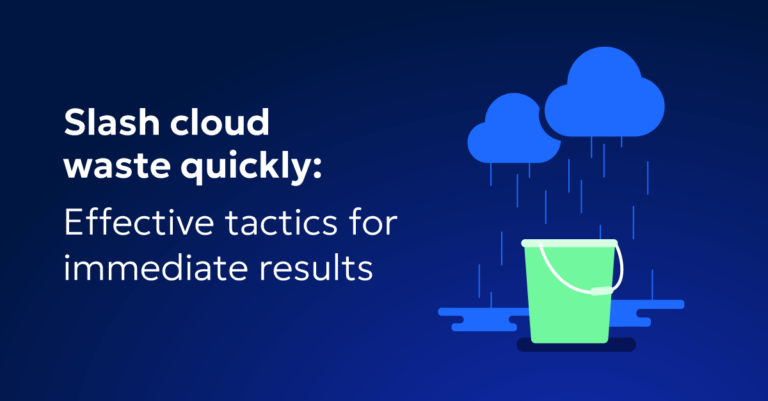
Slash Cloud Waste Quickly: Effective Tactics for Immediate Results
In the fast-paced world of financial operations, achieving and maintaining peak efficiency is not just a goal; it’s a necessity. Cloud waste is a common yet avoidable issue that can severely hamper your operational budget and efficiency. As an experienced FinOps professional, I understand the importance of staying ahead of the competition, maintaining control, and demonstrating excellence in my role. With my extensive experience in cloud cost management, I’m here to share strategies, which have helped me throughout my career, to reduce cloud waste and deliver immediate, tangible results.
Understand your cloud spending
The first step to reduce cloud waste fast is understanding where your money is going. Conduct a comprehensive audit of your cloud resources. Look at your usage patterns, identify underutilized or idle resources, and determine which services are costing you the most.
- Utilize Cost Management Tools: Use your cloud provider’a platform like AWS Cost Explorer, Azure Cost Management, and Google Cloud’s Cost Management can provide detailed insights into your spending patterns.
- Engage Third-Party Solutions: Tools such as Zesty can offer advanced analytics and automated optimizations, making it easier to identify waste and take corrective action.
Optimize resource allocation
Efficiency is about using exactly what you need—no more, no less. Fine-tuning resource allocation can lead to substantial savings.
- Rightsize Your Instances: Adjust your compute resources to match your actual workload needs. Zesty’s Commitment Manager, for example, can automatically adjust instance sizes based on real-time demand, ensuring you aren’t overpaying for capacity you don’t use.
- Leverage Spot Instances: Take advantage of lower-cost, non-guaranteed compute power for non-critical workloads. This tactic can yield significant cost savings without sacrificing performance.
Implement automation
Automation is your ally in the battle against cloud waste. By automating resource management, you ensure that resources are scaled up or down based on actual demand.
- Auto-Scaling Groups: Use auto-scaling to dynamically adjust resource levels in response to traffic and workload changes.
- Scheduled Jobs: Implement scripts to start and stop instances during off-peak hours, reducing unnecessary spending.
Invest in monitoring and recommendation tools
Constant vigilance is key to maintaining efficiency. Monitoring tools provide real-time insights into your cloud environment, while recommendation engines suggest optimizations.
- Real-Time Monitoring: Solutions like Amazon CloudWatch, Google Cloud Monitoring, and Azure Monitor offer real-time performance data and alerts. These tools help you track the performance and health of your cloud resources, enabling you to respond quickly to any issues and maintain optimal performance.
- Automated Recommendations: Third-party solutions such as Zesty, CloudHealth by VMware, and Turbonomic not only monitor your environment but also provide actionable recommendations tailored to your specific needs. These platforms analyze your usage patterns and offer suggestions for optimization, ensuring that you remain in control and ahead of potential waste. Zesty’s platform, for instance, can automate these optimizations, reducing manual intervention and improving efficiency.
Embrace serverless architectures
Serverless computing can significantly reduce costs by eliminating the need to manage and provision servers.
- Function-as-a-Service (FaaS): Use services like AWS Lambda, Azure Functions, or Google Cloud Functions to run code in response to events without provisioning or managing servers. You only pay for the compute time you consume.
- Serverless Databases: Opt for serverless database solutions like Amazon Aurora Serverless or Azure SQL Database serverless. These scale automatically based on demand and can lead to significant cost savings.
Implement tagging and cost allocation
Properly tagging resources is crucial for identifying and managing cloud waste.
- Consistent Tagging Policies: Implement and enforce a consistent tagging strategy across your organization. This helps in tracking usage, identifying untagged or mis-tagged resources, and attributing costs accurately.
- Automated Tag Audits: Regularly audit tags using tools like AWS Config Rules or Azure Policy to ensure compliance and identify any anomalies or missed tags.
Optimize storage costs
Storage is often a significant part of cloud expenses. Optimizing storage can lead to immediate cost reductions.
- Lifecycle Policies: Implement lifecycle policies to automatically transition data to lower-cost storage tiers based on access patterns. For example, move infrequently accessed data to Amazon S3 Glacier.
- Delete Unused Snapshots: Regularly review and delete unused snapshots and backups. Automate this process using scripts or third-party tools.
Case study: Heap’s success story
At Zesty, we’ve seen firsthand how effective cloud waste reduction can transform an organization’s financial outlook. Consider the case of Heap, a digital insights platform:
- The Challenge: Heap faced escalating cloud costs that threatened to outpace their revenue growth.
- Our Solution: By leveraging Zesty’s automated optimization tools, Heap was able to reduce their cloud spend by 30%. This significant saving allowed them to reinvest in their core business and stay competitive in a crowded market.
This success story isn’t unique. Businesses that take proactive steps towards reducing cloud waste quickly find themselves better positioned for growth and success.
Achieve immediate results with strategic cloud management
Reducing cloud waste isn’t just about saving money—it’s about demonstrating your strategic vision and operational excellence. By implementing these tactics, you’ll not only see immediate financial benefits but also position yourself as a leader in financial operations.
Take control, reduce waste, and propel your organization—and your career—to new heights.
Ready to see fast results? Start implementing these tactics today and watch your cloud costs shrink while your professional reputation soars.









